
Detecting AI-generated content is critical in 2025 as AI tools become more advanced and widespread. Here's a quick rundown of the top AI content detectors this year:
- Detecting-ai.com V2: Launched in January 2025, it leads with 99% accuracy, tested on 365 million samples. Plans start at $5/month annually.
- Copyleaks: Focused on academic and professional use, ideal for schools and publishers.
- ZeroGPT: Features multi-stage analysis and real-time detection for various AI models.
- Originality AI: Excels at detecting AI-edited content with a 97% accuracy rate.
- GPTZero: Popular in education, offering batch processing and perplexity analysis.
- AI Text Classifier: Basic detection with 60% accuracy, suitable for simple checks.
- Hugging Face: Part of a larger AI ecosystem, adaptable for developers.
- Sapling.ai: Enterprise-focused with sentence-level analysis and low false positive rates.
- Crossplag: Offers multi-language support and deep learning for nuanced detection.
- TrueText: A beginner-friendly, free tool with limited accuracy (76%).
Quick Comparison
| AI Detector | Accuracy | Features | Use Case | Pricing |
|---|---|---|---|---|
| Detecting-ai.com V2 | 99% | Detailed reports, privacy-focused | Enterprise verification, Academic integrity |
Free/$5-$10/mo |
| Copyleaks | High | Multi-language, education-focused | Academic integrity | Custom pricing |
| ZeroGPT | High | Real-time, multi-model analysis | Content verification | Quote-based |
| Originality AI | 97% | Human-edited AI detection | Professional writing | From $14.95/mo |
| GPTZero | Moderate | Perplexity analysis, batch processing | Education | Custom pricing |
| AI Text Classifier | 60% | Basic detection | Individual checks | Free |
| Hugging Face | Moderate | Developer integration | Technical applications | Free with limits |
| Sapling.ai | High | Low false positives, enterprise tools | Organization-wide checks | Quote-based |
| Crossplag | Moderate | Multi-stage, cultural context analysis | Academic and publishing | Custom pricing |
| TrueText | 76% | Simple interface | Basic content checks | Free |
For the most accurate and feature-rich detection, Detecting-ai.com V2 leads the pack. Choose based on your specific needs, whether academic, professional, or casual content verification.
Best AI Detectors 2025: Top 5 AI Content Detection Tools
1. Detecting-ai.com AI Detector
Detecting-ai.com has made waves in 2025 with its powerful Detector V2, launched on January 9, 2025. Detecting-ai.com is a top choice in 2025 for detecting AI-generated content. Trained on a massive dataset of 365 million samples, it boasts an impressive 99% accuracy rate, as confirmed by RAID benchmarks. This tool is designed to identify AI-generated content from models like ChatGPT, Gemini, Jasper, Claude, and even newer ones like GPT4.
The tool's standout features include AI detection highlighting and detailed reports. These make it easier to spot AI-generated text, which is especially useful for academic institutions, publishers, and content creators aiming to ensure originality and credibility.
| Plan | Price | Key Features |
|---|---|---|
| Free | $0/month | • 5,000 character limit • 100 detections/day • Basic features |
| Monthly | $10/month | • 160,000 character limit • Unlimited detections • Premium support • AI humanizer |
| Yearly | $5/month (billed annually) | • 160,000 character limit • Unlimited detections • Premium support • Best value option |
Detecting-ai.com prioritizes user privacy with its no-data-storage policy and features an easy-to-use interface. Its detailed reports make it a go-to solution for verifying content authenticity.
While Detecting-ai.com stands out for its accuracy and features, other options in the market also cater to different needs and preferences.
2. Copyleaks AI Detector
Copyleaks AI Detector is designed for verifying academic and professional content. Using machine learning, it identifies AI-generated material and incorporates additional content analysis tools, making it a strong choice for educators, researchers, and publishers.
This platform is particularly focused on the education and research sectors, helping institutions spot AI-generated submissions and uphold academic standards in the digital age. Its ability to analyze complex AI-created content is a key feature for organizations needing thorough verification.
Unlike Detecting-ai.com's RAID benchmarks, which emphasize transparency, Copyleaks prioritizes functionality in educational and research settings. It combines AI detection with other content verification tools for a well-rounded analysis.
| Feature Category | Capabilities |
|---|---|
| Detection Scope | • Identifies AI-generated content • Supports multiple AI models • Real-time analysis |
| Primary Use Cases | • Schools and universities • Publishers • Research institutions |
| Technical Features | • Machine learning-based detection • Comprehensive content analysis • Advanced text processing |
As AI detection tools continue to evolve, staying updated on Copyleaks' latest features is essential. While Copyleaks stands out in academic and research applications, tools like ZeroGPT may offer different benefits for detecting AI-generated content.
3. ZeroGPT AI Detector
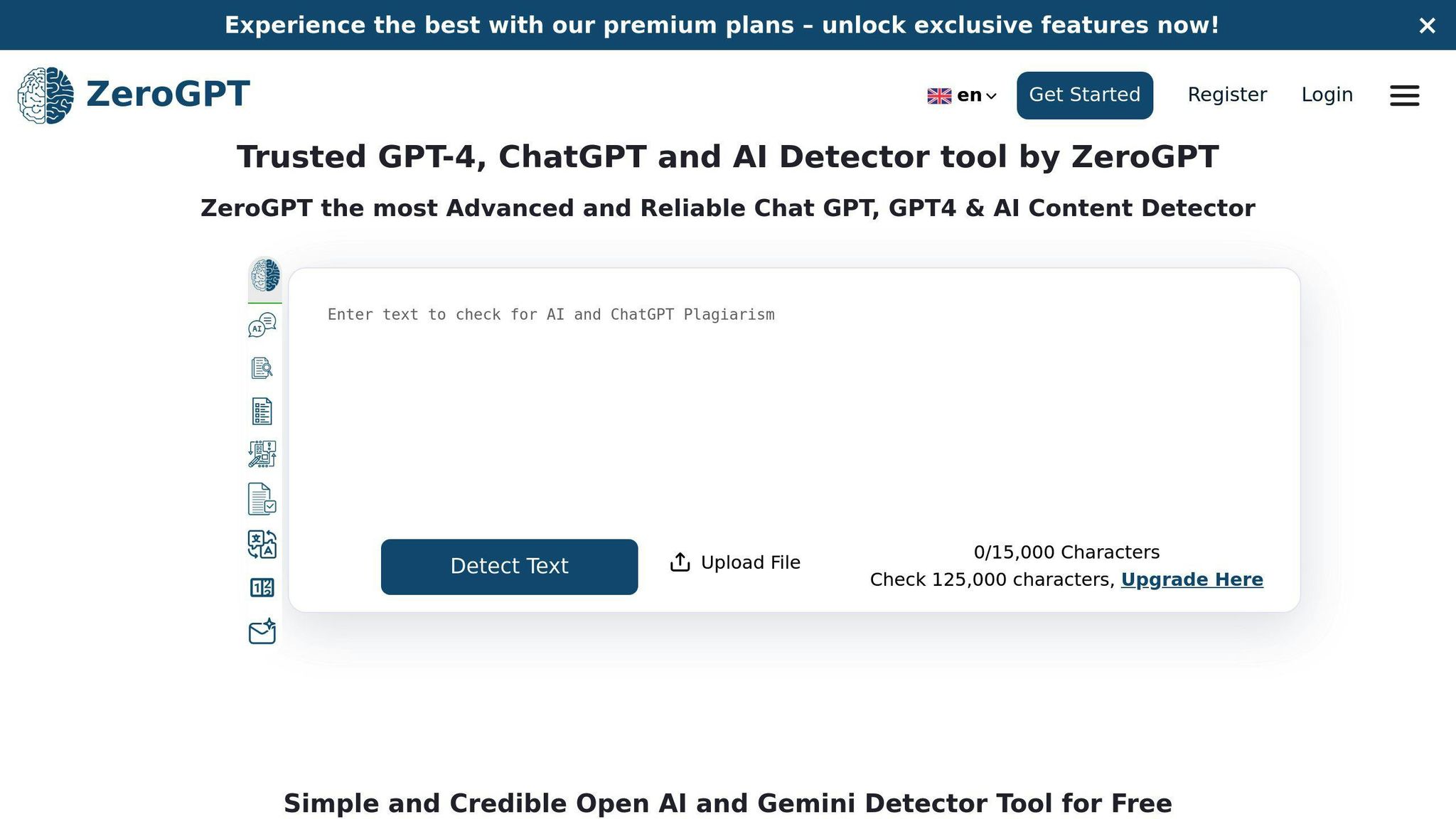
ZeroGPT AI Detector has emerged in 2025 as a reliable tool for identifying AI-generated content. It uses a multi-stage process to analyze text, effectively spotting content created by various language models like ChatGPT, GPT-4, Gemini, and LLaMa models. Its deep learning system is trained on a wide range of datasets, ensuring accurate results.
What sets ZeroGPT apart is its mix of advanced detection techniques and practical tools:
| Feature Category | Capabilities |
|---|---|
| Core Detection | • Detects AI-generated content • Recognizes multiple AI models • Employs multi-stage analysis |
| Content Tools | • Fixes grammar issues • Offers translation services • Provides citation tools |
| Accessibility | • Works on mobile platforms • Enables real-time detection |
ZeroGPT offers real-time detection through integrations with WhatsApp and Telegram, making it convenient for users who need instant content checks. Its multi-stage analysis reduces errors, while features like grammar correction, translation, and citation tools add extra value for users.
For businesses and individuals needing thorough content verification, ZeroGPT combines strong detection abilities with an easy-to-use interface. Its adaptive deep learning system keeps up with evolving AI writing styles, ensuring consistent performance across different types of content.
With its wide range of tools and seamless integrations, ZeroGPT is a dependable choice for various content verification needs. Next, let's see how the Originality AI Detector measures up in terms of accuracy and features.
4. Originality AI Detector
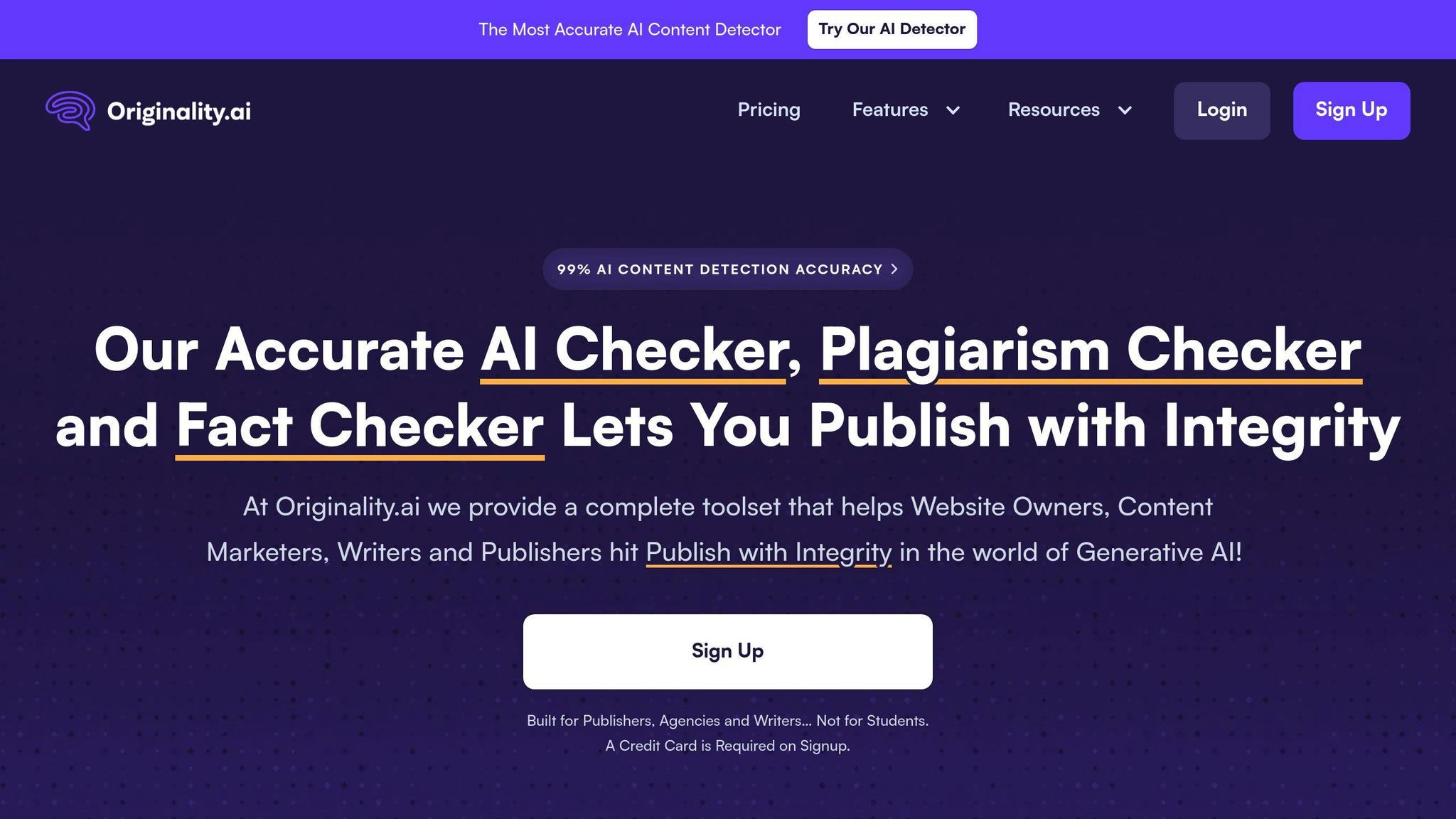
Originality AI Detector has become a top tool in 2025 for identifying AI-generated text in academic and professional settings. With a 97% accuracy rate across AI models like GPT-3.5 and GPT-4, it even performs well on paraphrased content.
This tool stands out for its detailed analysis system, which provides in-depth insights into text authenticity. Here's what you can expect from its features:
| Feature | Description |
|---|---|
| Sentence-Level Analysis | Pinpoints suspected AI-written sentences with accuracy percentages |
| Model Recognition | Identifies content generated by various AI language models |
| Report Generation | Produces detailed authenticity reports |
| Real-time Analysis | Enables instant content verification |
One of its standout abilities is detecting AI-generated text that has been edited by humans. This feature is especially useful in environments that demand high standards of originality, such as schools, universities, and professional workplaces.
The platform's interface is designed for ease of use, catering to both tech-savvy administrators and educators who may not have a technical background. Reports are straightforward and easy to understand, making the tool accessible to a wide audience. Additionally, it regularly updates its training data to keep up with the latest AI advancements, ensuring it can identify content from new models.
In academic settings, the tool has proven to be highly reliable. Its precision in spotting AI-generated content while minimizing false positives makes it a trusted choice for educators reviewing student submissions.
Originality AI's success lies in its ability to balance accurate detection with reliable verification of human-written text. This ensures high standards of authenticity while reducing the chances of wrongly flagging legitimate content.
While it excels in accuracy and user-friendly reporting, other tools like GPTZero offer additional features, such as broader integrations and real-time detection capabilities.
5. GPTZero AI Detector
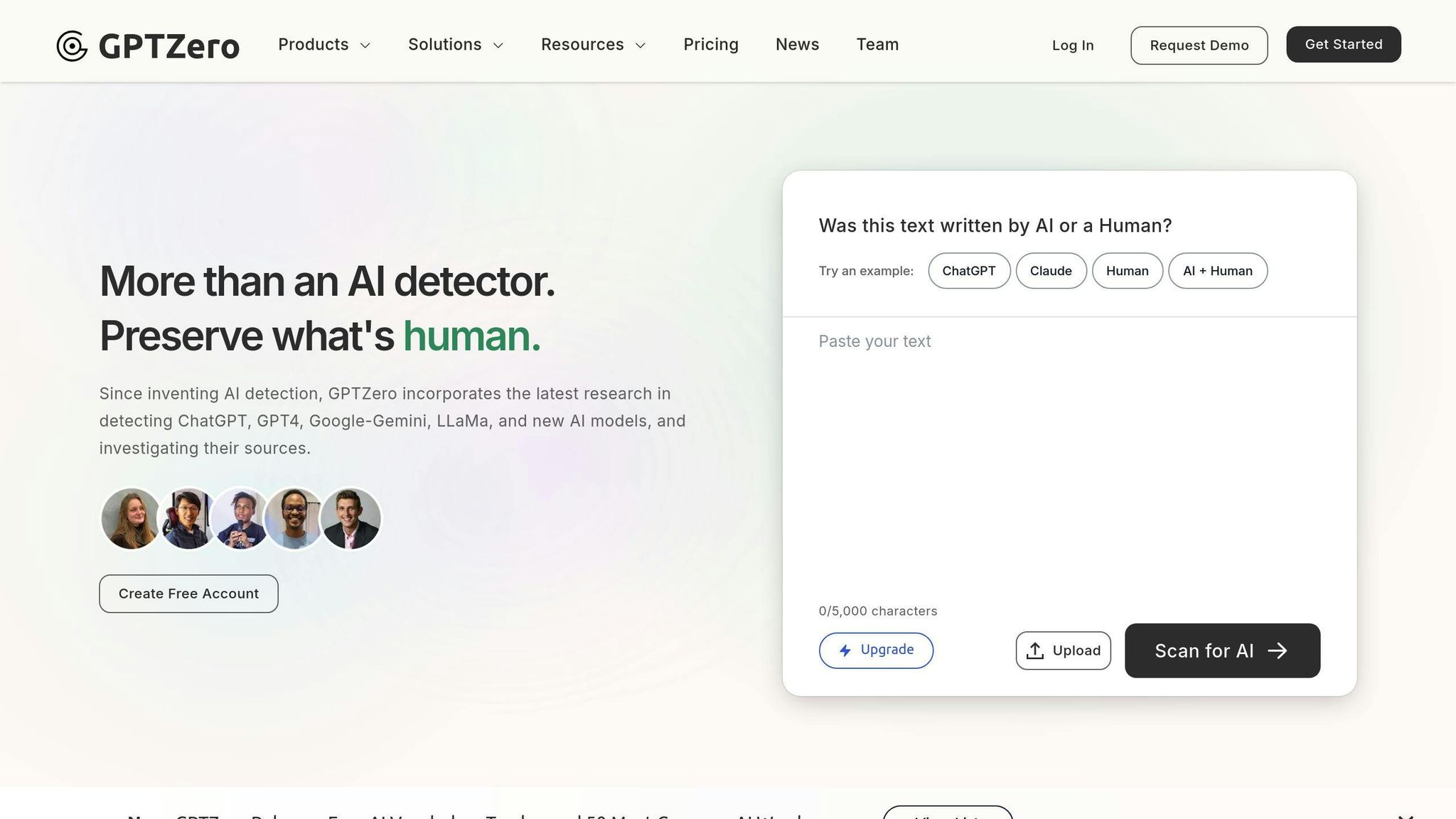
GPTZero AI Detector has become a key tool in spotting AI-generated content, using advanced language analysis to identify patterns typical of AI-produced text. It's designed to detect content from various AI language models and offers an interface that's easy to navigate for both tech-savvy users and those less familiar with such tools.
The detector works by analyzing sentence structures and word choices to flag AI markers, helping differentiate between human and machine-written content. It stays updated with new AI models to ensure it can handle evolving challenges in the field.
Here's a quick look at its standout features:
| Feature | Description |
|---|---|
| Advanced Detection | Uses sophisticated NLP algorithms to identify AI patterns and verify text in real time |
| Multi-Model Detection | Can recognize content generated by multiple AI language models |
| Report Generation | Provides detailed reports for content verification |
| Academic Tools | Includes specialized tools to support educational integrity checks |
GPTZero is widely used in academic settings, helping educators review student submissions with minimal errors in detection. Beyond education, it's also applied in areas like content marketing, publishing, and professional writing.
However, one drawback is its lack of publicly shared accuracy rates, which puts it behind competitors like Detecting-ai.com, known for a 99% precision rate. Detecting-ai.com's Detector V2, with its massive 365M sample training dataset, poses a strong challenge to GPTZero in terms of reliability and precision.
GPTZero also integrates with various platforms, making it a helpful option for individuals and organizations that need consistent content verification. Its performance can vary depending on the complexity and origin of the AI-generated content, so it's crucial for users to evaluate their specific requirements when selecting a detection tool.
While GPTZero shines in academic settings, other options like AI Text Classifier cater more to businesses and content creators, offering a broader range of applications.
6. AI Text Classifier
The AI Text Classifier is designed to spot AI-generated text using machine learning and natural language processing (NLP). It's a useful tool, but its accuracy is around 60%, which is notably lower than premium options that reach up to 84%.
| Feature Category | Capabilities |
|---|---|
| Detection Scope | Identifies text from various AI models, including GPT variants |
| Use Cases | Academic integrity, content moderation, publishing |
| Processing | Analyzes text in real-time and detects patterns |
| Integration | Works with different content management systems |
| Reporting | Provides basic classification results and confidence levels |
This tool is particularly helpful in fields like education and content moderation. However, it does have its limitations. It struggles with false positives, especially when analyzing technical or specialized content. To get the best results, it should be part of a larger, more comprehensive content verification process.
The AI Text Classifier gets regular updates to improve its detection, but its smaller training dataset means it lacks the precision of tools like Detecting-ai.com's model, which is trained on 365 million samples. If you're looking for higher accuracy and broader capabilities, advanced tools like Hugging Face AI Detector might be a better fit.
sbb-itb-207a185
7. Hugging Face AI Detector
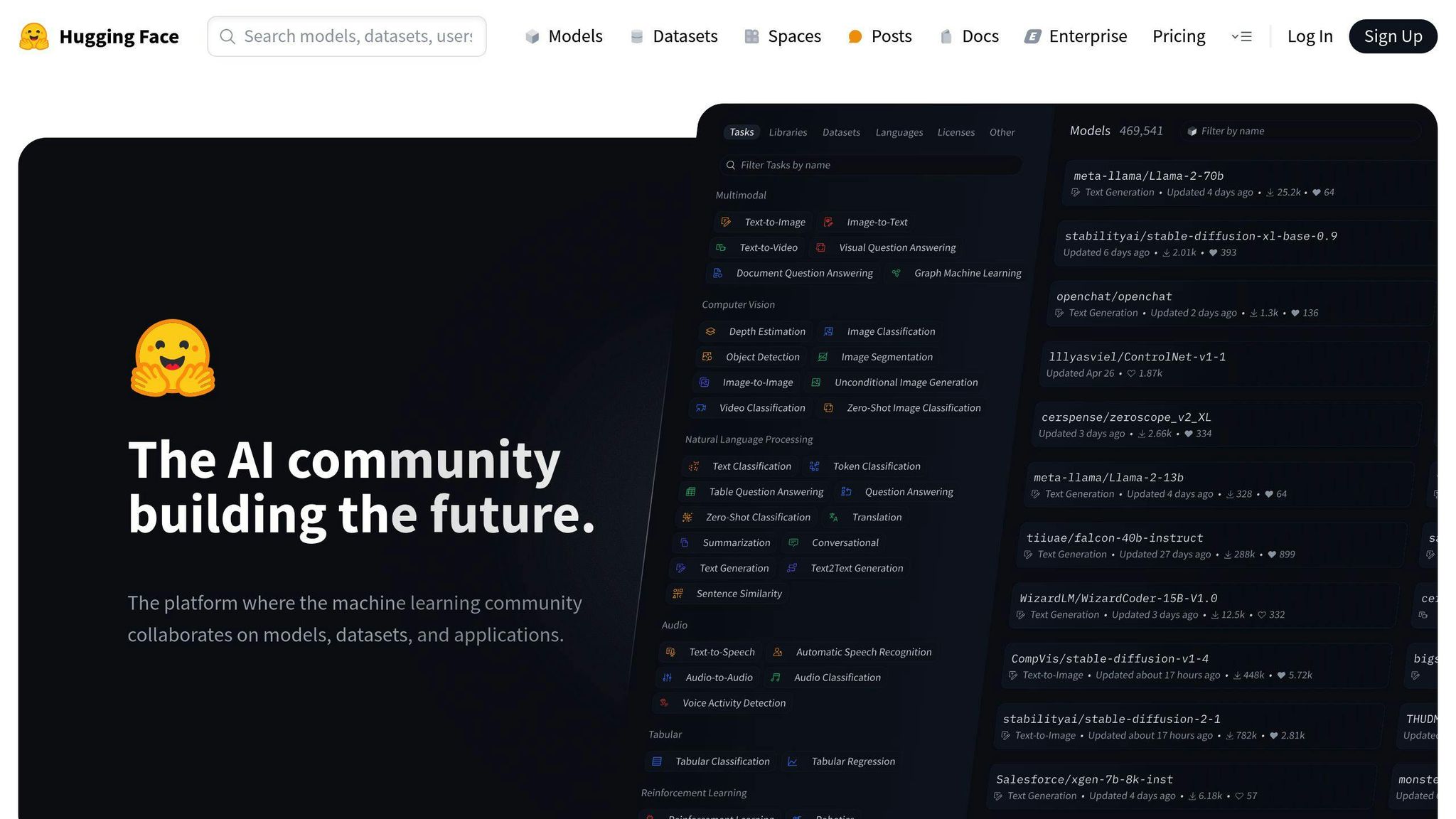
The Hugging Face AI Detector is part of the well-known Hugging Face ecosystem, which includes a range of pre-trained models. It uses advanced natural language processing (NLP) and machine learning techniques to spot AI-generated content with precision. Its design allows it to adjust to new patterns in AI-generated text, keeping it relevant as language models continue to change.
| Feature | Description |
|---|---|
| Technology Base | Advanced NLP and machine learning algorithms |
| Learning Capability | Adapts to new AI writing patterns |
| Integration | Works within Hugging Face's AI ecosystem |
| Use Cases | Academic integrity, content verification, plagiarism detection |
| Model Architecture | Built on pre-trained transformer models |
Being part of Hugging Face's ecosystem gives this tool a broader range of content analysis and verification features. While it doesn't claim the 99% accuracy rate of Detecting-ai.com, its ability to learn and improve through community-driven updates helps it stay effective against evolving AI writing methods.
Since it's open-source, the detector benefits from ongoing contributions from developers, ensuring it keeps up with the latest trends in AI writing. Its transformer-based architecture is especially good at analyzing detailed content patterns, making it a solid choice for academic and professional settings where verifying content authenticity is essential.
"The importance of reliable AI detectors in maintaining content authenticity and trustworthiness, especially in fields like education and academia, cannot be overstated".
Hugging Face's ability to adapt makes it a competitive option for organizations that need thorough content verification tools, especially when integrated into a larger AI framework.
8. Sapling.ai AI Detector
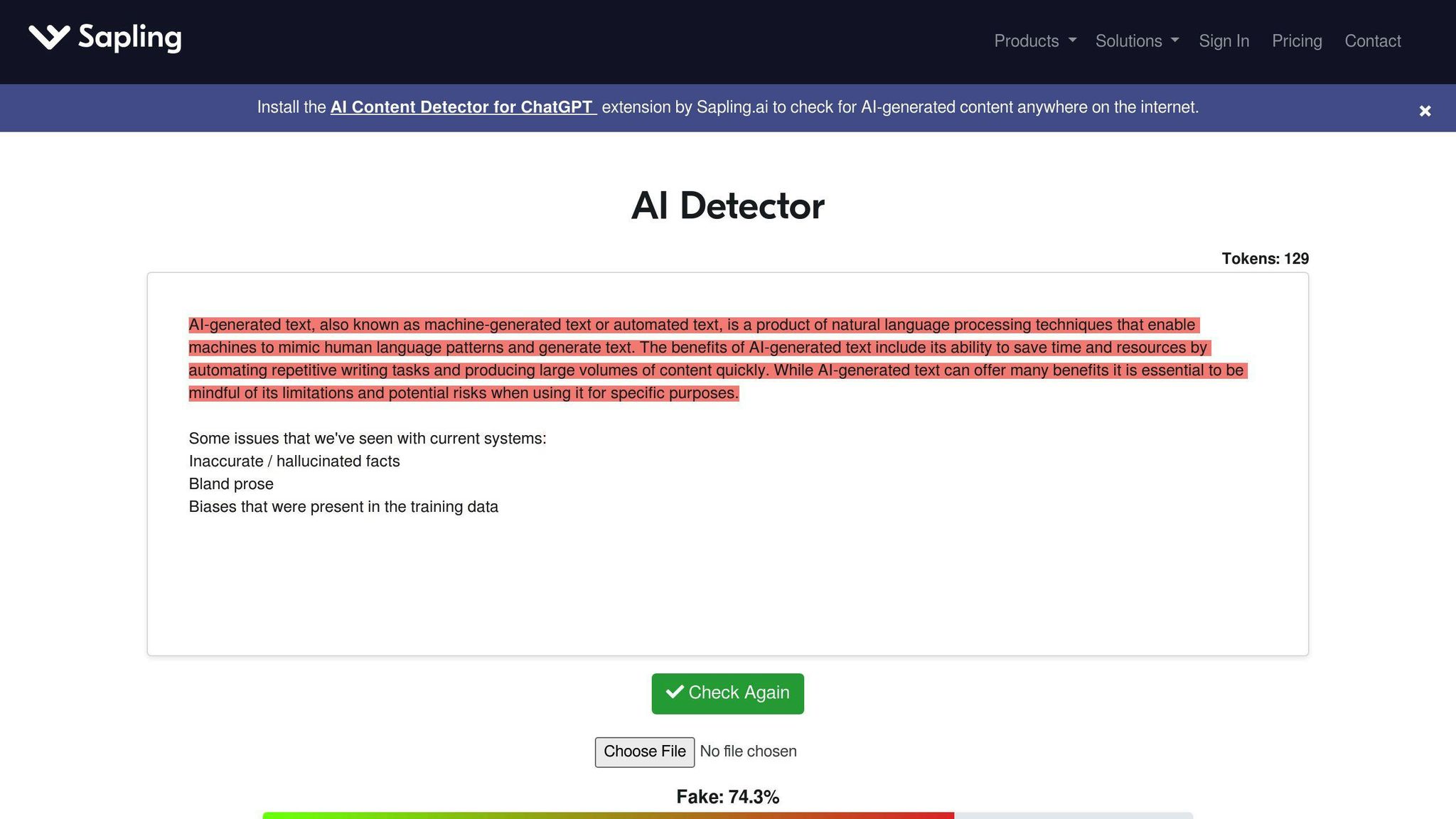
Sapling.ai is a good choice for detecting AI-generated content, known for its accuracy and features tailored to enterprise users. It uses advanced machine learning to analyze text patterns and pinpoint AI-generated material.
| Feature | Specification |
|---|---|
| Detection Accuracy | High precision for major AI models |
| False Positive Rate | ~0.1% for human-written text |
| Language Support | Supports multiple languages |
| Analysis Type | Sentence-level detection |
| Visual Feedback | Color-coded highlights for easy review |
One standout feature is its sentence-level analysis. Sapling.ai provides detailed insights by breaking down text sentence by sentence, paired with color-coded highlights that make identifying AI-generated content straightforward.
"I found Sapling AI Detector to be a useful tool for spotting AI-generated content, especially from models like ChatGPT and Gemini." - Andy Samue, Author
Sapling.ai offers flexible pricing, including free and enterprise-level plans, making it accessible for various users. It boasts high accuracy in detecting content from popular AI models like ChatGPT and Gemini, with a very low false positive rate (~0.1%) for human-written material. However, occasional false positives mean users should carefully review flagged content.
The interface is intuitive, providing instant results with percentage scores that indicate the likelihood of AI involvement. For businesses, Sapling.ai's API supports large-scale content verification, making it a strong option for companies handling significant amounts of text.
While Sapling.ai excels in detailed analysis and enterprise solutions, tools like Crossplag focus more on cross-platform use and broader language support.
9. Crossplag AI Detector
Crossplag AI Detector has gained attention in 2025 for its multi-step approach to identifying AI-generated content. Using advanced deep learning algorithms, it examines text patterns to detect AI content across different platforms.
| Feature | Description |
|---|---|
| Detection Method | Multi-stage deep learning analysis |
| False Positive Rate | ~2% for human-written content |
| Language Support | Multiple languages with cultural context |
| Integration Options | API access for enterprise users |
| Real-time Analysis | Instant results with confidence scores |
What sets Crossplag apart is its ability to combine cultural context with multi-stage analysis, reducing false positives and offering a deeper understanding of content structure and meaning.
For businesses, Crossplag provides API integration, making it ideal for processing high volumes of content. It also includes detailed analytics and reporting tools, helping organizations monitor detection trends over time.
While its pricing is in line with industry standards, like Originality.ai, Crossplag distinguishes itself by emphasizing cultural context in its analysis. This makes it especially useful for international companies needing nuanced content assessments.
However, Crossplag's accuracy and dataset size don't quite match Detecting-ai.com's 99% accuracy and 365 million sample training. Still, its user-friendly interface with instant confidence scores makes it a practical choice for quick evaluations.
Crossplag is widely used by academic institutions and publishers to ensure content integrity across various formats. While it excels in cultural context and multi-step analysis, other tools, like TrueText, may be better suited for specific industry needs.
10. TrueText AI Detector
TrueText AI Detector is a basic tool for identifying AI-generated content, offering a straightforward interface but falling short in terms of accuracy and advanced features. With a 76% accuracy rate, it works for simple detection needs but lags behind competitors like Detecting-ai.com, which boasts a 99% accuracy rate.
| Feature | Details |
|---|---|
| Accuracy Rate | 76% |
| Key Features | - Highlights AI-generated text - Basic detection tools - Free plan available |
| Pricing | Free plan with limited features |
| Integration Options | Limited information available |
| Main Strength | Easy-to-use, simple interface |
TrueText's ease of use and free plan make it appealing for casual users. However, its limited accuracy and lack of advanced tools leave it less suited for professional or academic purposes. For example, Detecting-ai.com's V2 model, with its 99% accuracy and training dataset of 365 million samples, far surpasses TrueText in precision and reliability.
The tool does not include a plagiarism checker or advanced analysis features, which are often essential for professional users. While its AI-text highlighting feature is helpful, it doesn't match the depth of analysis or detailed reporting provided by premium alternatives.
As AI detection tools continue to improve in 2025, TrueText remains a basic option for beginners. For those needing higher accuracy and more robust features, tools like Detecting-ai.com or Originality AI are better suited for professional tasks.
Comparison Table
Here's a breakdown of how the top AI content detectors stack up in 2025, focusing on their performance, features, and usability.
| AI Detector | Performance | Key Features | Main Use Case | Pricing |
|---|---|---|---|---|
| Detecting-ai.com V2 | Highest accuracy | Advanced engine, no registration | Enterprise content verification | Free tier; Premium from $5/mo |
| Copyleaks | Very high | Multi-language support, education-focused | Academic integrity management | Contact for pricing |
| ZeroGPT | High | Step-by-step analysis, wide model support | Content verification | Quote-based |
| Originality AI | Above average | Human-edited AI detection | Professional writing checks | Starts at $14.95/mo |
| GPTZero | Moderate | Perplexity analysis, batch processing | Student submission checks | Custom pricing |
| AI Text Classifier | Standard | Basic detection features | Individual content checks | Free |
| Hugging Face | Standard | Developer integration, customizable | Technical implementations | Free with limits |
| Sapling.ai | Standard | Team collaboration tools | Organization-wide checks | Quote-based |
| Crossplag | Standard | Combines plagiarism detection | Academic document analysis | Contact for pricing |
| TrueText | Basic | Simple interface, fast results | Basic content checks | Free with limits |
Key Insights
- Detection Accuracy: Detecting-ai.com V2 stands out with its extensive training dataset of 365 million samples, offering unmatched reliability in detection.
- Specialized Use Cases: Each tool has a specific focus. For instance, Originality AI targets human-edited content, while ZeroGPT supports a wide range of AI models.
- Accessibility and Pricing: Options range from free tools with limited features to premium services that include advanced capabilities and API integrations.
- Integration Options: Some tools, like Hugging Face, cater to developers with customizable solutions, while others offer user-friendly web interfaces for quick results.
Choosing the right AI detector depends on your needs - whether it's pinpoint accuracy, ease of use, or integration capabilities. Balancing detection reliability with practical requirements and budget will help you find the best fit.
Conclusion
By 2025, the way we verify content has been reshaped by advancements in AI-generated content detection. Tools like Detecting-ai.com's V2 model stand out, setting new benchmarks with RAID validation for enterprise-level precision.
When choosing the right detection tool, it's important to weigh key factors:
- Accuracy: Tools like Detecting-ai.com deliver top-tier precision, while others may only meet basic needs.
- Features: Some tools specialize in specific areas - Copyleaks is tailored for education, while Originality AI focuses on spotting human-edited AI content.
- Cost: Options range from free plans to premium services like Detecting-ai.com at $5/month, offering a mix of affordability and functionality.
- Ease of Use: Whether it's developer-friendly APIs or simple interfaces for quick checks, usability varies widely.
AI detection tools are evolving fast, making it essential to stay informed about the latest options. These tools are a critical part of ensuring originality and trust across industries as AI-generated content becomes more sophisticated.
Integrating these detectors into a broader verification strategy can enhance workflows and improve content authenticity. Keep an eye on new developments and select tools that align with your specific needs for reliable detection and seamless integration.
FAQs
What is the most accurate AI content detector?
As of January 2025, Detecting-ai.com's V2 model is considered the most accurate. It offers multi-language support and advanced pattern recognition, making it capable of identifying even subtly edited AI-generated content. This tool is particularly effective at spotting content from different AI models thanks to its detailed detection system.
Which AI detection is the most reliable?
Two tools are frequently highlighted for their reliability:
- Detecting-ai.com: The V2 model consistently performs well across various content types and languages, making it a top choice for enterprise-level needs.
- Originality.ai: Known for its ability to detect human-edited AI content, this tool minimizes false positives, which is crucial for professional content verification.
The reliability of detection tools can depend on the complexity of the content and the AI models used. Many organizations combine these tools for more thorough content verification. For a detailed breakdown of features, refer to the comparison table above.